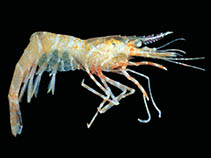Chorismus antarcticus (Pfeffer, 1887)
| Native range | All suitable habitat | Point map | Year 2050 |

|
| This map was computer-generated and has not yet been reviewed. |
| Chorismus antarcticus AquaMaps Data sources: GBIF OBIS |
Classification / Names Common names | Synonyms | CoL | ITIS | WoRMS
Malacostraca | Decapoda | Hippolytidae
Environment: milieu / climate zone / depth range / distribution range Ecology
Benthic; depth range 15 - 915 m (Ref. 87391), usually 200 - 500 m (Ref. 116006). Polar; ? - -1°C (Ref. 86841)
Distribution Countries | FAO areas | Ecosystems | Occurrences | Introductions
Antarctic.
Length at first maturity / Size / Weight / Age
Maturity: Lm 1.4 range ? - ? cm
Life cycle and mating behavior Maturity | Reproduction | Spawning | Eggs | Fecundity | Larvae
Main reference
References | Coordinator | Collaborators
Gutt, J., M. Gorny and W. Arntz 1991 Spatial distribution of Antarctic shrimps (Crustacea: Decapoda) by underwater photography. Antarc. Sci. 3(4):363-369. (Ref. 2660)
IUCN Red List Status
(Ref. 130435: Version 2025-1)
CITES status (Ref. 108899)
CMS (Ref. 116361)
Threat to humans
Human uses
| FishSource |
Tools
More information
Max. ages / sizes
Length-weight rel.
Length-length rel.
Length-frequencies
Mass conversion
Abundance
Internet sources
BHL | BOLD Systems | CISTI | DiscoverLife | FAO(Publication : search) | Fishipedia | GenBank (genome, nucleotide) | GloBI | Gomexsi | Google Books | Google Scholar | Google | PubMed | Tree of Life | Wikipedia (Go, Search) | Zoological Record



